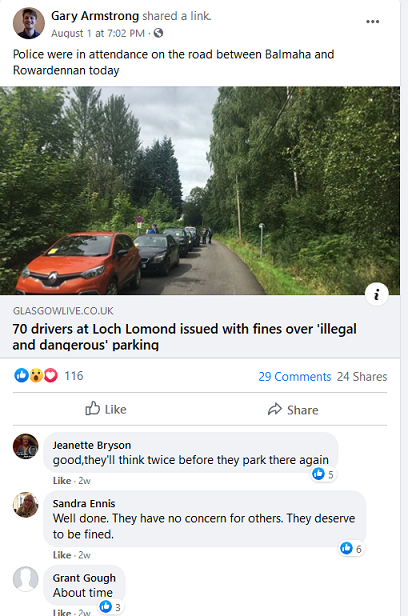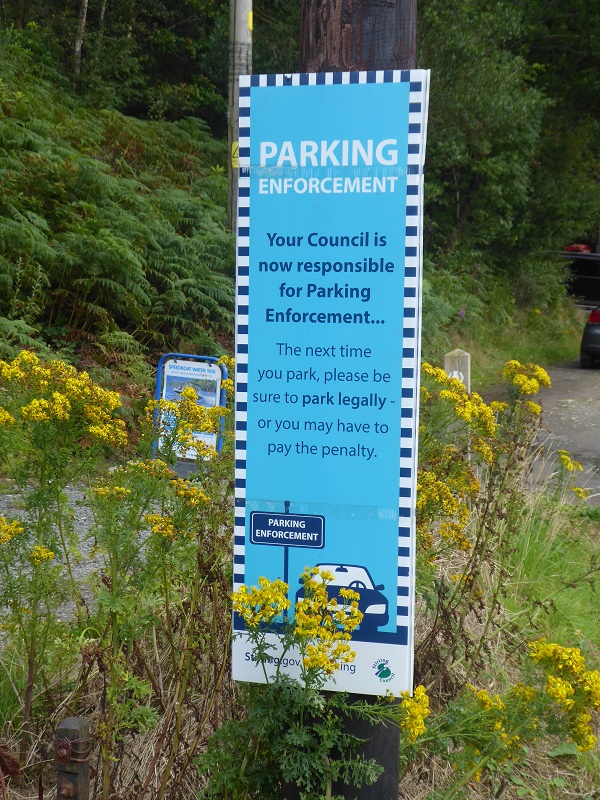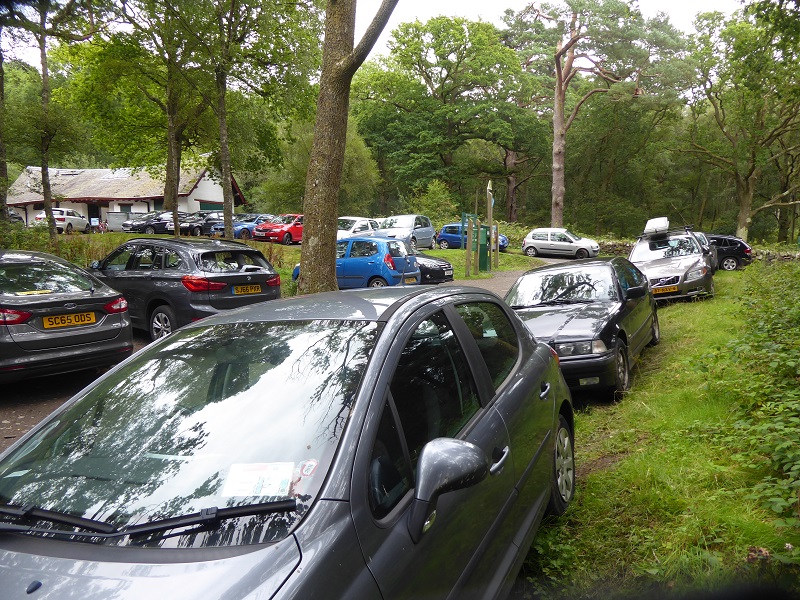A few weeks ago some friends went in their campervan to Glen Muick, on Deeside, and stopped off overnight in the lower part of the glen. They were woken in the early hours by the sound of passing traffic. They were stunned by the number of visitors, remarking that it was just like the Lake District. By the time they had breakfast, they reckoned the car park at the head of the glen would be full. But instead of turning round they left their wee campervan where it was and cycled up to the end of the road. Once they were away from the car park area, it was only the summits that were crowded.
Last week formal traffic management measures were introduced for Glen Muick with a 21 day traffic regulation order which enables the road to be closed when the car park is full (see here). This has been done in a generally helpful way by the Cairngorms National Park Authority working with Aberdeenshire Council. Traffic is allowed up the glen when there is space in the car park and there are staff on the barriers to ensure this happens effectively and advise people who need to be turned away. At Linn of Dee the road an additional overflow car park has been created.
The contrast with how our public authorities are dealing with similar traffic management issues in the Loch Lomond and Trossachs National Park could not be greater:

On east Loch Lomond, instead of managing the traffic, the initial response of the Loch Lomond and Trossachs National Park Authority was to let Stirling Council close the road through a Temporary Traffic Regulation Order. They have then allowed the world to drive to Rowardennan. Unsurprisingly when people have found the car park full, they have parked on the side of the road and then the council came along and with police support dished out fines.

The claim that this parking is dangerous is unwarranted. It may cause inconvenience, particularly for local residents, but traffic crawls along the glen. It’s just like a packed supermarket car park, chaotic and frustrating, but dangerous?
This approach may help Stirling Council and the Police meet any targets they have for raising income from fines or charging people, but it does nothing for the reputation of the National Park. Predictably, instead of the LLTNPA re-thinking its disastrous approach and developing new solutions (as the CNPA is doing) to increased demand to visit the countryside, it was the same again last weekend. 100 parking fines I am reliably informed.
Gordon Watson the LLTNPA Chief Executive was on Call Kay on Radio Scotland this week and, when challenged why the National Park Authority is not dealing with these issues, he lamely replied that no-one wants to cover the whole of the National Park in tarmac. Mr Watson and his Board should visit other National Parks in the British Isles where farmers open up their fields in summer, sometimes with temporary toilets, to create extra parking capacity. There clearly are solutions, the problem is the LLTNPA is not prepared to consider them.
The LLTNPA’s position on visitors, is fundamentally incoherent. On the one hand, they actively promote the National Park as a tourist destination, on the other they don’t want to provide any of the infrastructure needed to support this. A current illustration of this is the message springs out from the LLTNPA’s web page for visitors (see here):
 Just as with camping and the camping byelaws, the best solution the LLTNPA can offer to many issues is to try to deter or limit the number of people visiting the National Park.
Just as with camping and the camping byelaws, the best solution the LLTNPA can offer to many issues is to try to deter or limit the number of people visiting the National Park.
At the same time consider the end of this clip (see here) from Visit Scotland, which was again shown on TV at the weekend. It features a LLTNPA Ranger on Conic Hill stating “Only in Scotland can travelling so little make such a big difference”. In other words the LLTNPA is actively promoting that people travel to places like Balmaha where it has completely failed to address traffic issues since it was created in 2002 (see here.!. It is worth noting here that, with the current influx of visitors to the countryside, there would have been even more problems on east Loch Lomond if the owner of the Oak Tree Inn, Sandy Fraser, had not a few months ago got planning permission for a temporary car park on waste ground at Balmaha (see here).
Instead of giving a lead, the LLTNPA creates confusion in its messaging and leaves it to others to pick up the pieces.
Solutions to the problem of excess cars and traffic

The long-term and green solution to the traffic management issues at places like Rowardennan and Glen Muick, that lie at the end of dead end road, is to introduce minibus services at popular periods as happens in valleys all over the Alps. I have been advocating that since before the Loch Lomond and Trossachs National Park was created but nothing has happened, despite the number of jobs this could create and the improvement this would make to the “Visitor Experience”. It would require no more tarmac.
That solution, however, appears no longer feasible a long as Covid-19 is a risk and while record numbers of people are visiting the countryside. Bikes, however, could offer a partial solution, as they did for my friends. So why don’t both our National Parks actively work to support the creation of bike hire facilities on the model of Next Bike (see here) in places like Glen Muick and Rowardennan? On this model people wouldn’t have to hire the bike for the whole day, only for the time they were using it and could leave it at agreed bike stations. Just as in our towns, vans could then be used to re-distribute bikes to where they are needed. This, and the need to maintain the bikes, would create jobs.
In places like east Loch Lomond, flexible bike hire would also enable people to enjoy other walks. For example: biking out to Rowardennan and walking back to Balmaha; or biking to Cashell, walking on to Sallochy and the biking back. The current absence of places to park along east Loch Lomond and the clearway order has made it very difficult for most people to do this type of day walk there. A missed opportunity that the provision of a bike hire scheme would help to address.
Each bike hire scheme could involve a mixture of push bikes and electric bikes, for people who are less fit and might be deterred from walking up hills like Ben Lomond or Lochnagar by the thought of the additional cycle in.
With a bit of will, schemes could be set up in both our National Parks this year. It is predictable now – tried booking accommodation recently? – that high numbers of tourists will want to visit the countryside into what was previously the “off-season”. It is predictable too that as and when further outbreaks of Covid-19, there will be a need to close places where people meet indoors like pubs and restaurants. That, assuming the Scottish Government starts to act on the evidence and accepts that the risks of Covid-19 being transmitted outdoors is very low, will also serve to increase demand from people in the cities wanting to get out into the countryside on their days off. To places like Rowardennan and Glen Muick. The implications are that the amount of traffic into the countryside will remain high for the foreseeable future and will continue. The challenge to our National Park Authorities is to act.
Couple of points, “waste ground” in Balmaha, where is that.
Montrose House,Balmaha was an outdoor center which ended up in a developers hands. At the time of sale many of us asked the LLTNP to purchase it, they wanted nothing to do with it. Probably one of the largest area of land in Balmaha and so many kids from Glasgow got their first outdoor adventure at Montrose House.
Was there not a mini bus service offered many years ago, but it was withdrawn through lack of use.
Agree on bikes, ebikes can offer so much. For Glen Etive I have always said the ski center is an ideal hub for parking for people accessing Glen Etive. I know people don’t hold my views on the hydro schemes, I see an opporttunity for each powerhouse for charging points for EV. Contacted the Scottish Rights of way to enhance the right of way along Loch Etive, no reply. Reminds me of how Montrose House slipped in to private ownership.
Hi John, I was referring to the land being used as the temporary car park – maybe my language was a bit lax – but there is also a huge area of what I think everyone could call “waste ground”, the former recreational area, behind Montrose House and the National Park visitor centre. I have formerly argued that that would have been a much better site for new housing than the ancient woodland just down the road towards Drymen. You are spot on about Montrose House. Going back further, it used to be part of a network of houses in the countryside providing “fresh air fortnights” to children from Glasgow, a precursor to outdoor education centres. I had not realised the LLTNPA had refused to purchase it…………..We must not let people forget the aspirations of the past and need to keeping asking why they are not possible when our society is so much richer. Bikes would be a good idea for Glen Etive too – though I understand Dickins Hydro is now wanting to transport in more stuff for the hydro schemes by land (pipes etc) than by sea and if that happens, cycling and car access for locals and visitors could become quite unpleasant……………..
Farm fields have being used in the past for car parking mainly when highland games are in play .Councillors Council Police Armed forces Ambulance have all been involved. Perhaps they were better organised in the past
Another good example is the National Parks in America where the most popular parks offer a free (after you pay the admission fee) shuttle bus service. It’s a hop on and off service that, in the case of Yosemite, takes to various locations within the park.
The type of bike hire scheme described by Nick already operates in Norway and could easily be applied to many locations in our national parks. The necessary infrastructure and software to use e-bikes is readily available and all that is missing is the political will in Scotland to get the bikes moving.